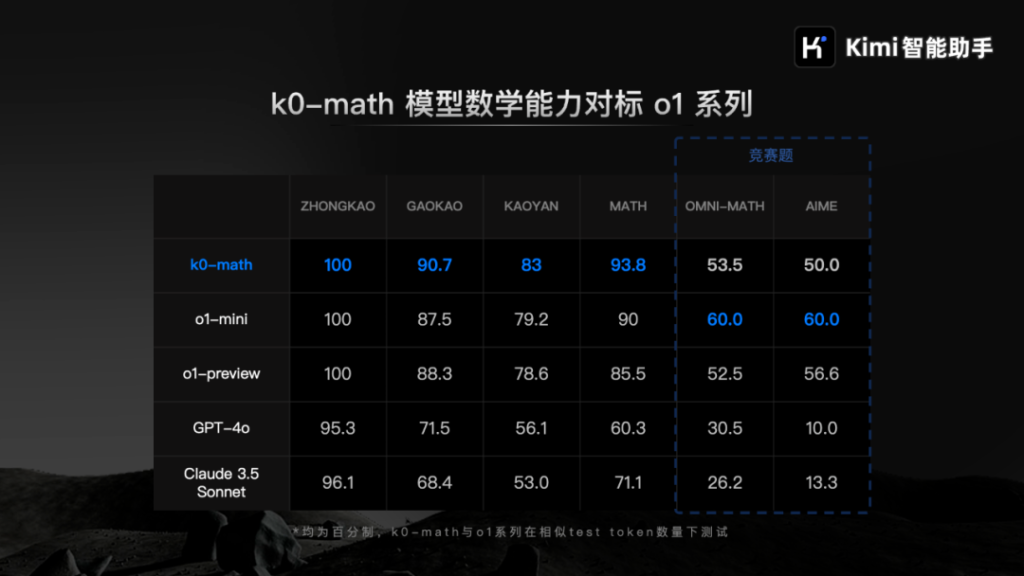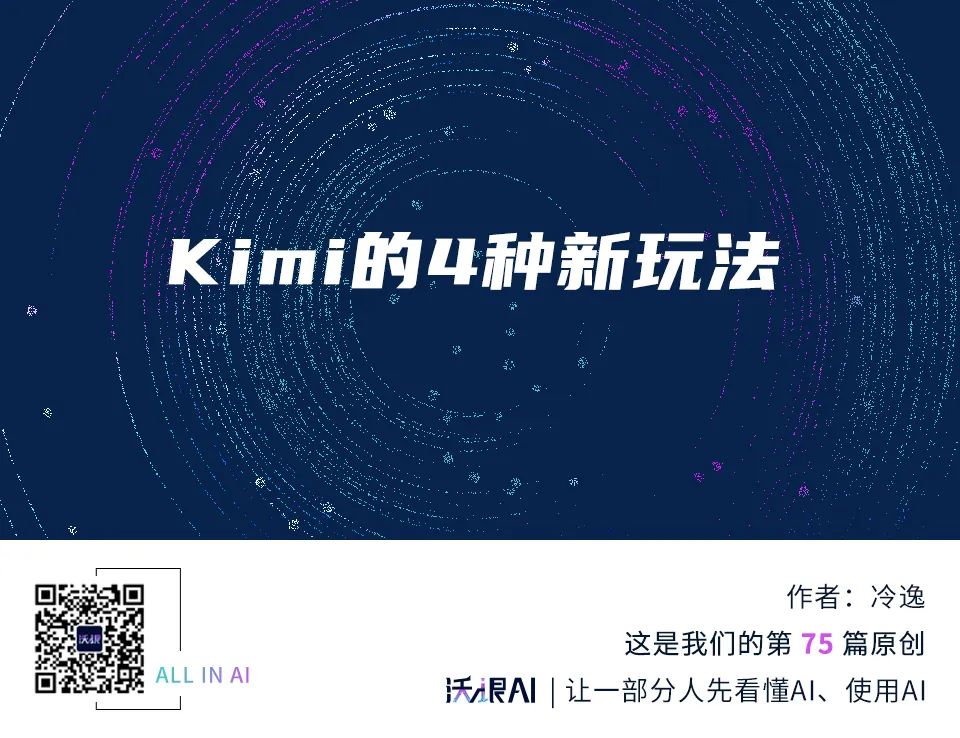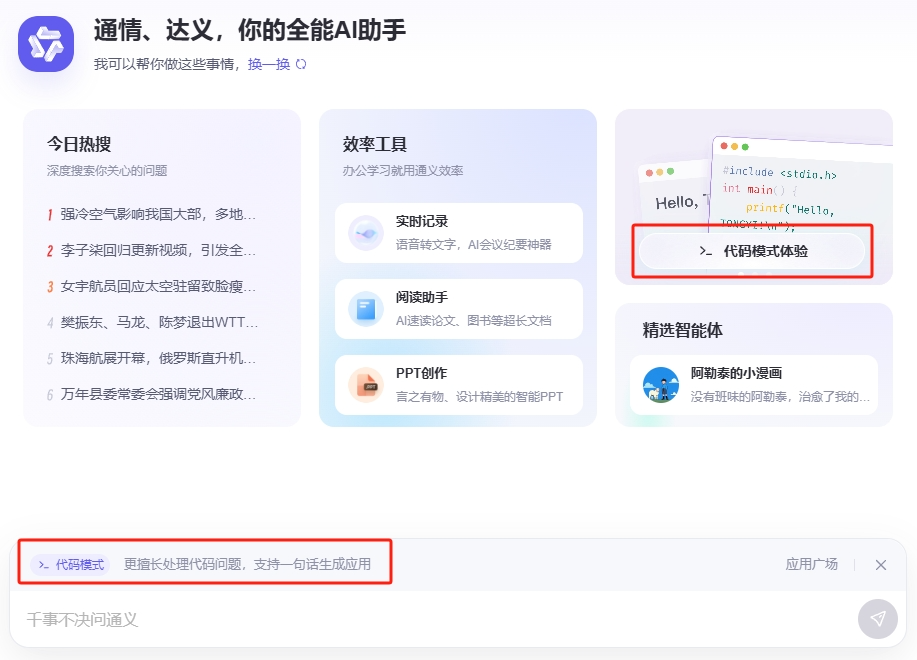Kimi’s o1 version is officially here. Last night, while using Kimi, I unexpectedly discovered that its k0-math mathematics model has gone live. On the sidebar, you can see the student wearing glasses, which is none other than Kimi’s math edition. What is Kimi’s math edition? The official introduction is here. In short, Kimi has launched the k0-math model, similar to the o1 model, which employs Self-play RL reinforcement learning and Cot thought chain technology.
This model can simulate human thinking and reflection processes, especially excelling in solving mathematical and reasoning problems, with an intellectual level comparable to that of a Ph.D. holder. Moreover, Kimi’s thought chains are fully exposed, which is highly commendable. For example, for the simplest question: 1+1=? Kimi’s mind successively flashed through nearly 20 calculation methods, including basic arithmetic, binary, group domain ring abstract algebra, dimensional calculation, set theory, abstract algebra, modular arithmetic, number line calculation, recursive calculation, and finally arrived at a confident conclusion: 2. Indeed, this confidence is well-founded.As an AI technology self-media, I have always wanted to know when I could reach a million followers. Let Kimi’s math edition help me calculate? Question 1: As a self-media blogger, assuming that each article I publish increases my followers by 100, and I currently have 100,000 followers, if I publish 20 articles a month, how long will it take to reach a million followers? What if I publish daily? The content is too long, and the screenshot is not fully displayed. You can visit this link to view the complete answer: https://kimi.moonshot.cn/share/ct1dhtprdij3dq4lkiq0. Impressively, to reach a million followers with monthly updates of 20 articles, it would take 37 years; maintaining daily updates, it would take 24 years. This plan seems to be aiming for me to work until retirement to reach a million followers! Everyone, do you understand the importance of your likes, watches, and shares? I really need your support!!
Now, what are the chances of me buying a lottery ticket downstairs? Question 2: Calculate the probability of me winning the double color ball lottery, which is 1 in 17,721,088, or one in seventeen million. Forget it, I’d better just keep working hard. The key point is, lotteries themselves are not scientific… At this point, attentive friends might have noticed that I made typos in the previous two questions. However, Kimi still accurately recognized my intentions and performed the calculations, which is a significant feature of the new Kimi exploration edition and math edition—it can understand users’ ambiguous expressions and perform reasoning or calculations. In other words, even though our questions may not be very precise, Kimi can still understand you and then help you with the calculations.
This is really useful for ordinary people. Because most of us (including me) actually have difficulty expressing ourselves accurately. Homophones, polysemous characters, and homographs caused by typos often occur in daily life. However, Kimi is just like an old friend who can still understand and help you.
Winter has come. If you want to control your weight, ask Kimi if it can help you create a diet plan. Question 3: I currently weigh 62 kg and exercise 4 days a week. I hope to maintain this weight before the Spring Festival in 2025. Please help me design a healthy diet plan – the calorie intake from Monday to Sunday, and tell me what I should eat every day according to my intake. Kimi’s reasoning process is really long, about 9,000 words… Here I only intercepted a part. You can visit this link to view the full answer. https://kimi.moonshot.cn/share/ct1e7sa1n4gn49dgehb0 You can also ask Kimi to directly output a table, which I will print out and stick on the refrigerator at home.
When I was a child, I was particularly curious about the story of praying for rain in Fengxian County in “Journey to the West”. How long does it take for the chicken to finish eating the rice and the dog to finish licking the flour? Question 4: Which is faster, for a chicken to finish eating a 1,000-ton mountain of rice or a dog to finish licking a 1,000-ton mountain of flour? 14,705,882 days (40,000 years) and 4,396,476 days (1,360 years). Goodness, Jade Emperor, you simply don’t intend to send rain. By the time the chicken finishes eating the rice and the dog finishes licking the flour, tens of thousands of years will have passed on earth. Due to the Attention mechanism, many AIs stumble on the strawberry problem (counting how many ‘r’s are in’strawberry’). So how did the k0-math model perform this time? Question 5: How many ‘k’s are there in ‘kimikkimikimi’? Answer: 4. Correct. Don’t underestimate this statistical problem. Even today, models without the Chain of Thought (Cot) are likely to answer it wrong. If they can’t answer correctly, how can users trust the AI to improve work efficiency? For example, counting how many people with a certain surname in a table, extracting a dataset with certain characteristics, and sorting out the amount of a certain company in an invoice. .. These are all very specific work scenario problems. If your model’s statistics are inaccurate and there are often data losses, how can I trust it? Kimi Math Edition seems to have solved this problem. Welcome everyone to test it and share your experience results in the comment section. What about reasoning? Has Kimi Math Edition improved? Let’s ask 2 common reasoning test questions. Friends familiar with WoYin AI know that these are our regular ‘actors’.Question 6: Xiao Hong has 3 brothers and 4 sisters. How many sisters does Xiao Hong’s brother have? Correct, 5 sisters.
Question 7: If everyone on Earth stood in the same place and jumped up and down simultaneously, what would happen to the Earth? Increase the difficulty by asking about a classic mechanical transmission problem designed by Yann LeCun, which is often used to test and evaluate AI’s logical reasoning and comprehension abilities. Question 8: 7 axles are equally spaced around a circle. A gear is placed on each axle such that each gear is engaged with the gear to its left and the gear to its right. The gears are numbered 1 to 7 around the circle. If gear 3 were rotated clockwise, in which direction would gear 7 rotate? Kimi answered correctly again, from logic to reasoning, all completely correct. As for doing postgraduate and college entrance examination questions, it’s even easier. For example, this undergraduate finance question. Question 9: Suppose you bought 500 shares of ABC Corporation’s stock on margin, with each share priced at $50, a margin requirement of 60%, and a margin interest rate of 10% (annualized). If you sold the stock at $45 per share after one year, and did not receive any margin call notices, what is your return on investment (ROI)? The answer is -23.33%. The original ROI should be -10% ((50-45)/50=10%), but with leverage, the loss is doubled. So, ordinary people investing, never add leverage. Finally, mathematics is the foundation of all sciences. Galileo Galilei once said, ‘The universe is written in the language of mathematics, and unless you first learn its language, you cannot read the universe.’ This is especially true for artificial intelligence. A year ago, we were still amazed by the text generation capabilities of LLM; a year later, the development of LLM has reached a new height – solving mathematical problems. In the second half of this year, AI won the silver award in the Olympiad, assisted top mathematicians in cracking difficult problems, and helped people unlock challenging tasks in work and life… The boundary of intelligence is constantly expanding.The mathematical reasoning capabilities of Large Language Models (LLM) have been significantly improved through the integration of Cot thinking chains and Self-play Reinforcement Learning (RL) techniques, such as those represented by models o1, kO-math, and DeepSeek R1. This enhancement allows AI to further elevate its reasoning abilities and intelligence across various fields and scenarios.
Kimi, as a leading figure in China’s AI industry, has been the first to complete the technological layout of Cot and introduce the mathematical model k0-math, which is now available for use.



